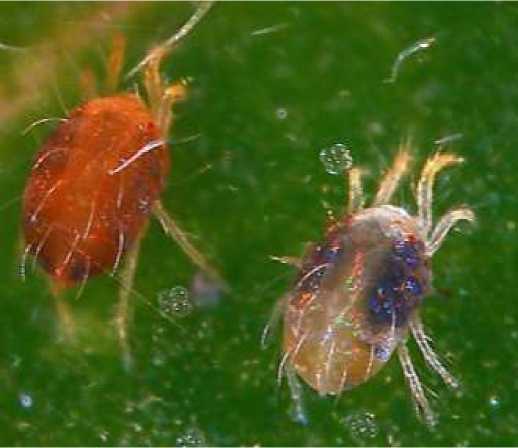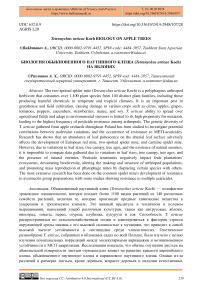Tetranychus urticae Koch biology on apple trees
Автор: Rakhmanov A.
Журнал: Бюллетень науки и практики @bulletennauki
Рубрика: Сельскохозяйственные науки
Статья в выпуске: 10 т.10, 2024 года.
Бесплатный доступ
The two-spotted spider mite ( Tetranychus urticae Koch) is a polyphagous arthropod herbivore that consumes over 1,100 plant species from 140 distinct plant families, including those producing harmful chemicals in temperate and tropical climates. It is an important pest in greenhouse and field cultivation, causing damage to various crops such as citrus, apples, grapes, tomatoes, peppers, cucumbers, strawberries, maize, and soy. T. urticae ability to spread over agricultural fields and adapt to environmental stressors is linked to its high propensity for mutation, leading to the highest frequency of pesticide resistance among arthropods. The genetic diversity of T. urticae gathered from apple orchards throughout Poland has been studied to investigate potential correlations between molecular variations and the occurrence of resistance to METI-acaricides. Research has shown that an abundance of leaf pubescence on the abaxial leaf surface adversely affects the development of European red mite, two-spotted spider mite, and carmine spider mite. However, due to variations in leaf sizes, tree canopy, tree ages, and the existence of natural enemies, it is impossible to compare data gathered due to variations in leaf sizes, tree canopy, tree ages, and the presence of natural enemies. Pesticide treatments negatively impact fruit plantations' ecosystems, devastating biodiversity, altering the makeup and structure of arthropod populations, and promoting mass reproduction of phytophage mites by displacing certain species with others. The most extensive research has been done on the common spider mite's development of resistance to avermectin group preparations, with some studies showing resistance to multiple acaricides.
Mites, egg, larvae, tetranychus urticae, pests, greenhouse, resistance
Короткий адрес: https://sciup.org/14131387
IDR: 14131387 | УДК: 632.8.9 | DOI: 10.33619/2414-2948/107/28
Текст научной статьи Tetranychus urticae Koch biology on apple trees
Бюллетень науки и практики / Bulletin of Science and Practice
One of the most polyphagous arthropod herbivores is the two-spotted spider mite ( Tetranychus urticae Koch), which belongs to the class Arachnida, the order Acari, and the family Tetranychidae. It is capable of consuming over 1,100 plant species from over 140 distinct plant families, including those that produce harmful chemicals in temperate and tropical climates [1].
T. urticae is an important pest in greenhouse and field cultivation that causes damage to a variety of crops, including citrus, apples, grapes, tomatoes, peppers, cucumbers, strawberries, maize, and soy. By draining plant juices from leaf cells, spider mites cause damage to plants. This results in white to yellow stippling on foliage as chlorophyll is lost, and severely afflicted annuals are frequently perished. T. urticae is ability to spread over the world's agricultural fields and its ability to adjust to environmental stressors are linked to a number of distinct characteristics, such as a high propensity for mutation. These characteristics promoted evolution and led to the highest frequency of pesticide resistance among arthropods. Only a few years after their introduction, chemicals like organophosphates, dicofol, and abamectin were found to fail in the chemical control of spider mites due to this resistance.
Resistance of Tetranychus species against a novel class of insecticides that are members of the mitochondrial electron transport inhibitor family. While potential biochemical reasons for METI-acaricide resistance have been suggested, the underlying molecular underpinnings of this phenomenon are yet unknown. Conventional genetic research findings suggest that a single main gene may regulate the two-spotted spider mite's resistance to METI-acaricides. The genome of T. urticae showed that, in contrast to other insects, the gene families linked to detoxification were more numerous. The study's objectives were to ascertain the genetic diversity of T. urticae gathered from apple orchards throughout Poland and to investigate any potential correlations between the molecular variations and the occurrence of resistance to METI-acaricides.
There has been much debate on the relationship between Tetranychus urticae Koch population density and hair density on the abaxial leaf surface. The majority of researchers have demonstrated that the development of the European red mite ( Panonychus ulmi Koch), two-spotted spider mite ( T. urticae Koch), and carmine spider mite ( T. cinnabarinus Boisduval) is adversely affected by an abundance of leaf pubescence on the abaxial leaf surface.
Additionally, research conducted in 1965 by Kamel and Elkassaby on the vulnerability of various cotton cultivars to carmine spider mite infestation showed that on cultivars with high hair density, this species developed the least. Diverse writers have reported varying trends in the relationship between spider mite population and leaf pubescence on the underside of apples and strawberries' leaves. They discovered that a greater quantity of hairs on the underside of strawberries' and apples' leaves had a beneficial effect on the spider mite population density. But Paiva and Janick (1980) found no evidence of a substantial relationship between the amount of hair on the leaves of Distinct apple clones and the degree of European red mite invasion. The majority of surveys that were given mentioned a relationship between the amount of hair on the abaxial leaf surface and the degree to which various spider mite species have colonized the leaf. However, because these studies were conducted in various field settings, it is impossible to compare the data gathered because of variations in leaf sizes, tree canopy, tree ages, and the existence of natural enemies [2].
Industrial fruit plantations, nurseries, vegetables grown in open and protected spaces, as well as flower and decorative crops, are severely harmed by phytophage mites. In the taxonomic organization of the apple tree entomoacarocomplex in Crimea, the Acariformes order makes up between 14.2% and 17.5% of the total. Amphytetranychus viennensis Zacher and Panonychus ulmi Koch, two mite species belonging to the Tetranychidae family, have dominated apple trees over the last ten years. Tetranychus urticae Koch and Tetranychus turkestani Ug et Nik were mass-produced in certain years.
The temperature in the room affects how the embryo develops. The development of the embryo occurs in 15 days at +15°C and only takes 2-3 days at +30°C. Of the unfertilized males, females emerge from the fertilized eggs. In contrast to adults, spider mite larvae have three pairs of legs. Following the initial stage of development, larvae mature into nymphs, which resemble adults and have four pairs of legs. A generation has a life expectancy of either 7-8 days or 30-36 days, depending on the temperature. The aforementioned preparations are ineffective if the room temperature falls below +18°C and if the resultant solution is stored for longer than a day.
A minimum of three sprinkles spaced nine to ten days apart are needed at a temperature of + 20°Ρ, and three to four sprinkles spaced three to four days apart are needed at a temperature of + 30°Ρ. If not, females that have emerged from the egg will lay eggs again after reaching maturity in 6-7 days at a temperature of + 30°C. The biotic and abiotic factors that affect apple trees cause a continual change in the species makeup of hazardous arthropods. Fruit plantations' ecosystems are negatively impacted by pesticide treatments. Their frequent use devastates biodiversity, alters the makeup and structure of arthropod populations, and promotes the mass reproduction of phytophage mites by displacing certain species with others [3].
The most extensive research has been done on the common spider mite's development of resistance to the avermectin group preparations. It has been observed in T. urticae populations that are geographically separated and gathered in the Canary Islands, the Netherlands, and the State of Florida. It is observed that resistance develops in the Dutch population two years after beginning abamectin treatment, whereas in California, the same species has remained constant for four years following the beginning of treatment. Following seven to eight years of widespread usage of this acaricide, populations of T. urticae in pear gardens in Washington and Oregon were found to be resistant to abamectin in 1994–1995 [4].
As a result of natural mite populations from Brazil, France, Italy, and the United States developing acaricide resistance, three resistant populations were found to have emerged in Germany after seven generations of monitoring. Out of the 11 T. urticae populations that were collected on roses in Colombia in 2001, only one was found to be abamectin-sensitive. After 12 generations, laboratory experiments conducted in China verified the emergence of a resistant T. urticae race when given abamectin treatment. The acaricides bifenthrin, dicofol, and fenbutatin oxide were not effective against T. urticaeraces found in Belgium, and no resistance to abamectin was found. The natural population of bromopropylate-resistant common spider mites in Iraq did not exhibit crossresistance to abamectin [5].

Figure. The spider mites Tetranychus urticae (right) and Tetranychus evansi (left) coinfesting a plant (Anna Beber)
Herbivores' selection of host plant can also be influenced by other variables. For instance, they might stay away from plants that are rivals. This could be as a result of herbivorous arthropods changing the characteristics of their host plant. It is true that many alterations brought about by herbivores are harmful to both conspecific and heterospecific consumers, whether it is through the induction of plant defenses or the consumption of plant diseases. Some herbivores may opt to lay their eggs on less crowded host plants in order to escape the detrimental impacts of competition, even if those plants are of poorer nutritional grade. As an alternative, they might select hosts where the offspring's performance is independent of density, perhaps to save money on potential future overcrowding expenses.
Conclusion
Tetranychus urticae Koch is a serious worldwide pest that damages a wide range of plants, such as flowers, vegetables, and fruit trees. In apple orchards, acaricides are frequently employed to control T. urticae ; however, the effects are limited by the existence of resistant populations. Because of its short life cycle, high reproductive potential, and haplo-diploid parthenogenesis, T. urticae is comparatively vulnerable to pesticide resistance. Acaricides' decreasing shelf life means that effective management depends on tracking local population resistance. Population dynamics heavily depend on aerial dispersal, the mode of which varies with the environment. In field populations, declining environmental circumstances, higher predator densities, and acaricide use accelerate aerial dispersal..
Список литературы Tetranychus urticae Koch biology on apple trees
- Anorbaev A. R., Rakhmanov A. K. Main species of spider mites (Acariformes: Tetranychidae) in pome fruit orchards and degree of their occurrence // ISJ Theoretical & Applied Science, 07 (87). 2020. P. 257-260. EDN: LHNOWK
- Тулаева И. А., Прах С. В. Токсикологическое и биохимическое тестирование популяции обыкновенного паутинного клеща Tetranychus urticae Koch из яблоневого сада центральной зоны садоводства Краснодарского края // Вестник защиты растений. 2009. №2. С. 65-66. EDN: KJVNNN
- Милевская И. А. Влияние иммиграции, наличия хищников (Typhlodromus pyri), погодных условий и обработки травянистой растительности гербицидами на плотность популяций обыкновенного паутинного клеща (Tetranychus urticae) в насаждениях яблони.(Канада) // Экологическая безопасность в АПК. Реферативный журнал. 2009. №1. С. 142-142. EDN: KARNDB
- Ягодинская Л. П. Эффективность акарицидов против клещей-фитофагов на плодовых культурах // Биология растений и садоводство: теория, инновации. 2016. №142. С. 128-138. EDN: XAMXSD
- Балыкина Е. Б., Ягодинская Л. П., Рыбарева Т. С., Балицкий Н. В. Влияние акарицидов на и изменение структуры акарокомплекса клещей-фитофагов // Бюллетень Государственного Никитского ботанического сада. 2017. №123. С. 58-64. EDN: YTUTRP


